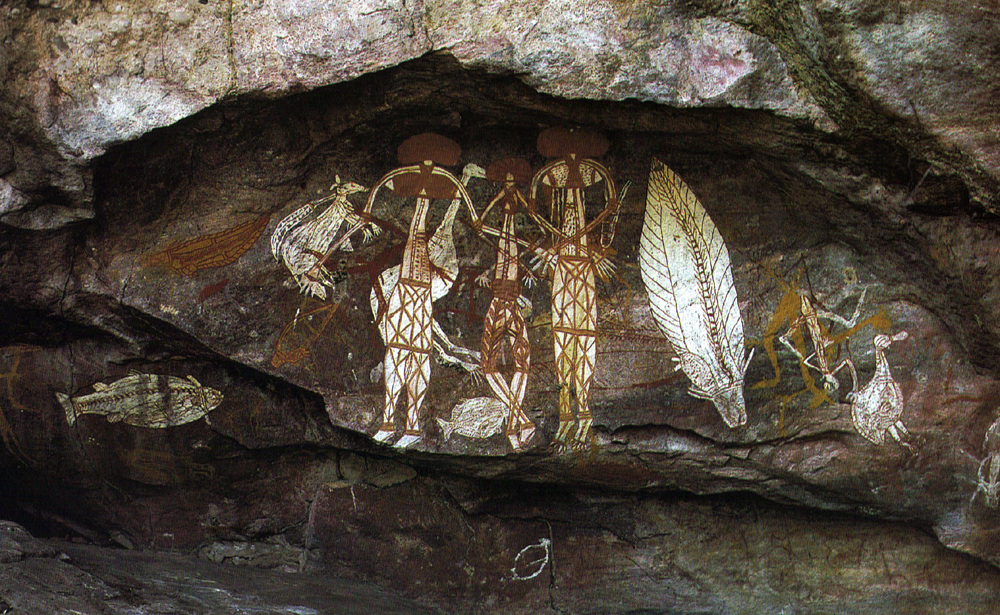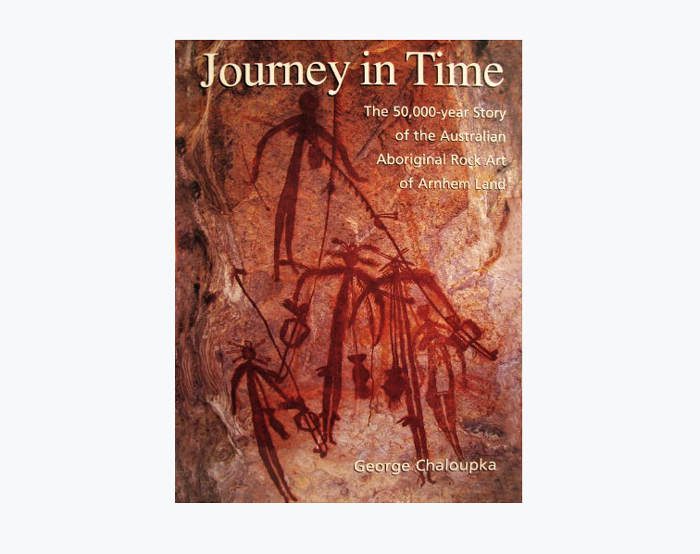


The Age of Australian Rock Art: following on with the research of George Chaloupka (1932 - 2011) in 'Journey in Time' we report on his assessment of the antiquity of the rock art of Australia.

A complex and varied rock art composition from the Namarrgon site complex in Arnhem Land. The central figures may depict a man and his wives.
A dramatic development in rock art research occurred in Australia in 1988, when results from a complex process known as cation-ratio dating provided absolute dates for rock engravings found at the Karolta site, in the Olary province of South Australia, some 100 kilometres west of Broken Hill. Physical geographer Ronald Dorn and rock art researcher Margaret Nobbs collaborated to measure the age of the rock varnish which has developed over the engravings since their execution. It was revealed that the series of engravings subjected to analysis were produced between 16,100 to 31,400 years ago. After their results and the dating technique itself were questioned, Dorn and Nobbs carried out further sampling at this site using the time-tested radiocarbon method in conjunction with the previously used, less reliable cation-ratio dating. The dates obtained from their research suggests that the rock engravings at Karolta and other sites in the Olary region were made over a long period of time, commencing before 36,000 years ago. Recently Dorn and Nobbs released dates of engravings from two other localities in that region extending the time of this art technique's commencement back to 42,000 years ago.
Engraving an image into a hard rock surface by pecking, pounding or abrading is a complex and skilful task, making it unlikely that these successfully dated engravings were the first creative expressions of a visual art form of the local group, or of others living elsewhere in Australia. Long before then, the storytellers and men of knowledge would have accompanied their discourses, as do Aboriginal narrators of today, by illustrating their tales with designs drawn with fingers or sticks in the sand or soil of their campsites. Others, who sought protection in the rock shelters from the inclement weather, may have originally used pieces of charcoal from their fires to outline the salient points of their stories with sketches on the walls and ceilings of overhangs. Perhaps it was not much later that they collected the coloured earth to use as pigments, or picked up a harder rock to engrave images into rock surfaces.
Recent research, including the recording and dating of faceted pieces of ochre ground by an artist to prepare pigment, suggests that a painted shelter in Arnhem land - the 'stone country' - was first occupied some 50,000 years ago.

Visit the Australian Rock Art Archive:
by Bradshaw Foundation
Monday 30 May 2022
by Bradshaw Foundation
Wednesday 19 January 2022
by Bradshaw Foundation
Thursday 06 January 2022
by Bradshaw Foundation
Monday 06 December 2021
by Bradshaw Foundation
Monday 29 November 2021
by Bradshaw Foundation
Monday 25 October 2021
by Bradshaw Foundation
Monday 12 July 2021
by Bradshaw Foundation
Monday 24 May 2021
by Bradshaw Foundation
Tuesday 20 April 2021
by Bradshaw Foundation
Thursday 01 April 2021
by Bradshaw Foundation
Tuesday 23 February 2021
by Bradshaw Foundation
Thursday 14 January 2021
by Bradshaw Foundation
Friday 18 December 2020
by Bradshaw Foundation
Sunday 06 December 2020
by Bradshaw Foundation
Thursday 26 November 2020
by Bradshaw Foundation
Wednesday 07 October 2020
by Bradshaw Foundation
Monday 30 May 2022
by Bradshaw Foundation
Wednesday 19 January 2022
by Bradshaw Foundation
Thursday 06 January 2022
by Bradshaw Foundation
Monday 06 December 2021
by Bradshaw Foundation
Monday 29 November 2021
by Bradshaw Foundation
Monday 25 October 2021
by Bradshaw Foundation
Monday 12 July 2021
by Bradshaw Foundation
Monday 24 May 2021
by Bradshaw Foundation
Tuesday 20 April 2021
by Bradshaw Foundation
Thursday 01 April 2021
by Bradshaw Foundation
Tuesday 23 February 2021
by Bradshaw Foundation
Thursday 14 January 2021
by Bradshaw Foundation
Friday 18 December 2020
by Bradshaw Foundation
Sunday 06 December 2020
by Bradshaw Foundation
Thursday 26 November 2020
by Bradshaw Foundation
Wednesday 07 October 2020
Friend of the Foundation











